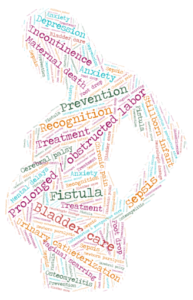By Elly Arnoff, FC+ Program Associate – Evaluation & Research; Lauri Romanzi, FC+ Project Director; Vandana Tripathi, FC+ Deputy Director
 On June 20, 2017, at the 31st International Confederation of Midwives (ICM) Triennial Congress in Toronto, Canada, the U.S. Agency for International Development (USAID)–supported Fistula Care Plus (FC+) project at EngenderHealth convened a breakfast panel discussion cosponsored by Bard Medical on postpartum care following prolonged/obstructed labor (P/OL).
On June 20, 2017, at the 31st International Confederation of Midwives (ICM) Triennial Congress in Toronto, Canada, the U.S. Agency for International Development (USAID)–supported Fistula Care Plus (FC+) project at EngenderHealth convened a breakfast panel discussion cosponsored by Bard Medical on postpartum care following prolonged/obstructed labor (P/OL).
The panel was moderated by Dr. Lauri Romanzi, FC+ Director, and involved the following panelists:
- Vandana Tripathi, FC+ Deputy Director
- Pandora Hardtman, International Midwifery Consultant
- Ekpoanwan Esienumoh, Senior Lecturer and Professor of Midwifery at University of Calabar, Nigeria
- Jeffrey M. Smith, Vice President, Jhpiego
You can listen to the entire panel discussion and watch the slide presentations here.
Dr. Romanzi opened the panel by reminding participants of the many sequalae related to P/OL: Women may experience fistula, sepsis, foot drop, and chronic depression/anxiety, and infants may experience cerebral palsy or even stillbirth, to name a few.
Dr. Tripathi began her presentation by emphasizing that the World Health Organization has called obstructed labor “the most disabling of all maternal conditions,” by contributing to 2.8% of global maternal mortality and complicating 3–6% of deliveries. Despite the gravity of P/OL, substantial gaps and inconsistencies exist in the guidance available to the skilled birth attendants (SBAs) who manage the condition. The research and clinical literature on P/OL provides no clear, consensus definition on the condition, and the terminology associated with it varies, leading to delays in identification of, referral for, and management of P/OL. Additionally, much of the guidance for SBAs does not provide sufficient information on postpartum evaluation and management of P/OL. The majority of the global health focus on the sequelae of P/OL is restricted to identifying and treating obstetric fistula, with no training programs for evaluating and managing other incontinence conditions, mental health sequelae, hypoxic encephalopathy conditions suffered by live born infants, foot drop, diastasis pubis, infertility, or severe vaginal scarring. These sequelae often occur together, and there is limited understanding of the extent to which these conditions contribute to stigma, isolation, and an ability to return to a normal life.[1]
Catheterization is a crucial component of P/OL management and of primary and secondary obstetric fistula prevention.[2],[3],[4] First, catheter insertion during P/OL keeps the bladder empty, so that the passage of the baby is not blocked during labor. Second, short- to medium-term duration of postpartum catheterization may prevent fistula after P/OL, though the evidence base for its efficacy and effectiveness is minimal. Third, a growing body of evidence suggests that catheterization of a bladder that has a fresh fistula may allow the fistula to close spontaneously, without surgical intervention.[5]
While the literature on fistula contains more guidance on the postpartum period, there are still important inconsistencies, such as the recommended duration of time for urinary catheterization after P/OL. To understand the range of postpartum practices that SBAs employ, FC+ launched an online global survey targeting SBAs from low- and middle-income countries on intrapartum and postpartum practices related to P/OL and bladder care management. Dr. Tripathi presented the preliminary findings from the survey’s pilot phase, highlighting the considerable variation in responses on how SBAs define P/OL, the criteria they use to assess it, and the amount of time they catheterize after P/OL. Dr. Tripathi concluded by encouraging attendees to take the survey and share it widely with their SBA network, so that the findings represent the reality on the ground and so practitioners can better support SBAs in managing P/OL.
Dr. Hardtman started her presentation with an evocative case study of how midwifery-led prevention and conservative management of obstetric fistula through urinary catheterization has a profound impact for women who experience P/OL and reduces the need for surgical repair of fistula. Not only is urinary catheterization a cost-effective alternative to surgery, but it also capitalizes on nurses’ and midwives’ existing skill set. Dr. Hardtman introduced three important guidelines for the clinical management of obstetric fistula and urinary catheterization: 1) WHO’s Obstetric fistula: Guiding principles for clinical management and programme development (2006); 2) the East, Central, and Southern African Health Community’s The prevention and management of obstetric fistula: A curriculum for nurses and midwives (2012); and 3) the Nigeria Federal Ministry of Health’s Guidelines on urethral catheterization for prevention and management of obstetric fistula in Nigeria (2016). While these resources provide concrete guidance to SBAs, the theory-to-practice gap in implementing these practices remains considerable, due to challenges such as the requirement of physician orders before midwives can perform certain interventions and inadequate water and supplies. As a result, these guidelines have not been widely adopted by midwives and nurses. After a discussion of the guidelines, the moderator underscored three distinct points when clinicians can utilize urinary catheterization to address obstetric fistula: 1) intrapartum, if the patient cannot void during labor; 2) immediately following P/OL, as a primary prevention strategy; and 3) during the postpartum period, as conservative treatment of fistula.
Dr. Esienumoh discussed midwifery-managed prevention and conservative management of obstetric fistula efforts in Nigeria. The Nursing and Midwifery Council of Nigeria (NMCN) regulates the practice of midwifery in Nigeria and participates in the formulation of all Federal Ministry of Health (FMOH) guidelines, including the recently released catheterization guidelines. Following the release of the guidelines, NMCN has been working with the FMOH to develop and disseminate related guidelines specifically for nurses and midwives. They are also working on integrating a preservice package into existing curricula for nurses and midwives and updating other training curricula with content from these guidelines. Dr. Esienumoh emphasized that it is critical for nurses and midwives to be at the forefront of developing and implementing such guidelines, and those implementation strategies should be both sustainable and donor-driven.
Dr. Smith discussed the issue of maternal and early newborn sepsis as an additional consequence of P/OL. Dr. Smith stressed the need for a more comprehensive and approach to manage P/OL and its related sequelae and encouraged childbirth clinicians to reflect on whether current approaches contribute to increased infections and complications in labor, citing how increased cesarean section rates also lead to infection or iatrogenic fistulae. Despite substantial progress in reducing maternal mortality over the last two decades, especially in regard to postpartum hemorrhage and pre-eclampsia, there are still considerable gaps in how clinicians address more complex cases. Dr. Smith reviewed the services offered in basic and comprehensive emergency obstetric care facilities and called for innovative approaches to providing intensive obstetric care for complex maternal cases. He stated that P/OL is as severe and urgent an obstetric emergency as eclampsia, hemorrhage, and fetal distress and that it falls upon the maternal health community to make sure that this level of priority includes P/OL in every facility providing childbirth services. Dr. Smith explained that current global guidelines addressing maternal sepsis recommend use of simple antibiotics; however, this requires a series of eight intravenous injections in the first 24 hours after delivery, and doing so is challenging in low-resource settings, where there are considerable shortages of health care workers. Alternative antibiotic regimens that are both effective and simple to implement need to be developed. Dr. Smith concluded by emphasizing the need to think more critically about P/OL and the various dimensions of maternal newborn infection that go along with it.
While time was limited, panel attendees generated a lively and thoughtful discussion following the formal presentations. One attendee noted that partographs are often completed after deliveries are over, distorting their intended purpose in labor monitoring and identifying prolonged/obstructed labor. Panelists discussed the need for integrated training and support that covers the partograph as part of a continuum of care. (Prior work by EngenderHealth and its partners on the partograph also addresses these challenges[6],[7]. Attendees also discussed the steps involved in building nursing and midwifery capacity to implement the new guidelines and empowering them to optimize their skills and roles in managing P/OL. Dr. Smith pointed out that lessons can be learned from other interventions and services that midwives have integrated into their practice and that all new service provision approaches are opportunities to collect data and document the efficacy of these changes.
Those interested in learning more about intrapartum and postpartum bladder care, management of prolonged/obstructed labor, and urinary catheterization for the prevention of obstetric fistula may consult the following resources:
Bailey, P., Fortney, J., Freedman, L., et al. 2002. Improving emergency obstetric care through criterion-based audit. New York: Averting Maternal Death and Disability (AMDD) Project/Columbia University. Accessed at: www.mailman.columbia.edu/sites/default/files/pdf/criterionbased_auditen.pdf.
Canterbury District Health Board (ed). 2015. Intrapartum and postnatal bladder care. Canterbury, UK: Maternity Guidelines Group. Accessed at: www.cdhb.health.nz/Hospitals-Services/Health-Professionals/maternity-care-guidelines/Documents/GLM0038-Bladder-Care-Intrapartum-and-Postnatal-232105.pdf
East, Central and South African Health Community (ECSA-HC) and Fistula Care/EngenderHealth. 2012. The prevention and management of obstetric fistula: A curriculum for nurses and midwives. New York: EngenderHealth/Fistula Care. Accessed at: www.engenderhealth.org/files/pubs/fistula-care-digital-archive/3/3.1/Prevention-Management-Nursing-Curriculum-English.pdf.
Graham, W., Wagaarachchi, P., Penney, G., et al. 2000. Criteria for clinical audit of the quality of hospital-based obstetric care in developing countries. Bulletin of the World Health Organization 78(5):614-620. Accessed at: www.who.int/bulletin/archives/78(5)614.pdf.
Hancock, B., & Browning, A. 2009. Practical obstetric fistula surgery. London: Royal Society of Medicine Press. Accessed at: www.glowm.com/resources/glowm/pdf/POFS/POFS_full.pdf.
Lewis, G., and De Bernis, L. 2006. Obstetric fistula: Guiding principles for clinical management and programme development. Geneva: World Health Organization. Accessed at: www.who.int/reproductivehealth/publications/maternal_perinatal_health/9241593679/en/
Nigeria Federal Ministry of Health. 2016. Guidelines on urethral catheterization for prevention and management of obstetric fistula in Nigeria. Abuja. Accessed at: https://fistulacare.org/blog/2017/02/nigeria-launches-guidelines/.
World Health Organization (WHO). 2004. Making pregnancy safer: The critical role of the skilled attendant: A joint statement by WHO, ICM and FIGO. Geneva: World Health Organization. Accessed at: http://www.who.int/maternal_child_adolescent/documents/9241591692/en/
WHO. 2008. Education material for teachers of midwifery: Midwifery education modules. –2nd ed. Managing prolonged and obstructed labour. Geneva. Accessed at: www.who.int/maternal_child_adolescent/documents/3_9241546662/en/.
WHO, United Nations Population Fund (UNFPA), United Nations Children’s Fund (UNICEF), and Averting Maternal Death and Disability (AMDD) Project. 2009. Monitoring emergency obstetric care: A handbook. Geneva. Accessed at: http://apps.who.int/iris/bitstream/10665/44121/1/9789241547734_eng.pdf
WHO. 2010. Managing complications in pregnancy and childbirth: A guide for midwives and doctors. Geneva. Accessed at: https://www.k4health.org/sites/default/files/4%20WHO_mgt%20complications%20and%20childbirth%202003_0.pdf
[1] Drew, L. B., Wilkinson, J. P., Nundwe, W., et al. 2016. Long-term outcomes for women after obstetric fistula repair in Lilongwe, Malawi: a qualitative study. BMC Pregnancy and Childbirth, 16(1), 2. doi: 10.1186/s12884-015-0755-1.
[2] Lewis, G., and De Bernis, L. 2006. Obstetric fistula: Guiding principles for clinical management and programme development. Geneva: World Health Organization (WHO). Accessed at: www.who.int/maternal_child_adolescent/documents/9241593679/en/.
[3] Nigeria Federal Ministry of Health. 2016. Guidelines on urethral catheterization for prevention and management of obstetric fistula in Nigeria. Abuja.
[4] East, Central and South African Health Community (ECSA-HC) and Fistula Care/EngenderHealth. 2012. The prevention and management of obstetric fistula: A curriculum for nurses and midwives. New York: EngenderHealth/Fistula Care. Accessed at: https://fistulacare.org/wp-content/uploads/pdf/Training/nursing_curriculum_2012_forweb.pdf.
[5] Isah, A., Romanzi, L., and Levin, K. 2016. Conservative treatment of obstetric fistula: A quick review from supported facilities in Nigeria. Presentation at the International Scientific Conference of the International Society of Obstetric Fistula Surgeons, Oct. 24–28, Abuja, Nigeria
[6] Fistula Care and Maternal Health Task Force. 2012. Revitalizing The partograph: Does the evidence support a global call to action?—Report of an expert meeting. New York, November 15-16, 2011. New York: EngenderHealth/Fistula Care. Accessed at: https://fistulacare.org/wp-content/uploads/pdf/program-reports/EngenderHealth-Fistula-Care-Partograph-Meeting-Report-9-April-12.pdf.
[7] Bedwell, C., Levin, K., Pett, C., et al. 2017. A realist review of the partograph: When and how does it work for labour monitoring? BMC Pregnancy and Childbirth 17(31), 2. doi: 10.1186/s12884-016-1213-4.


